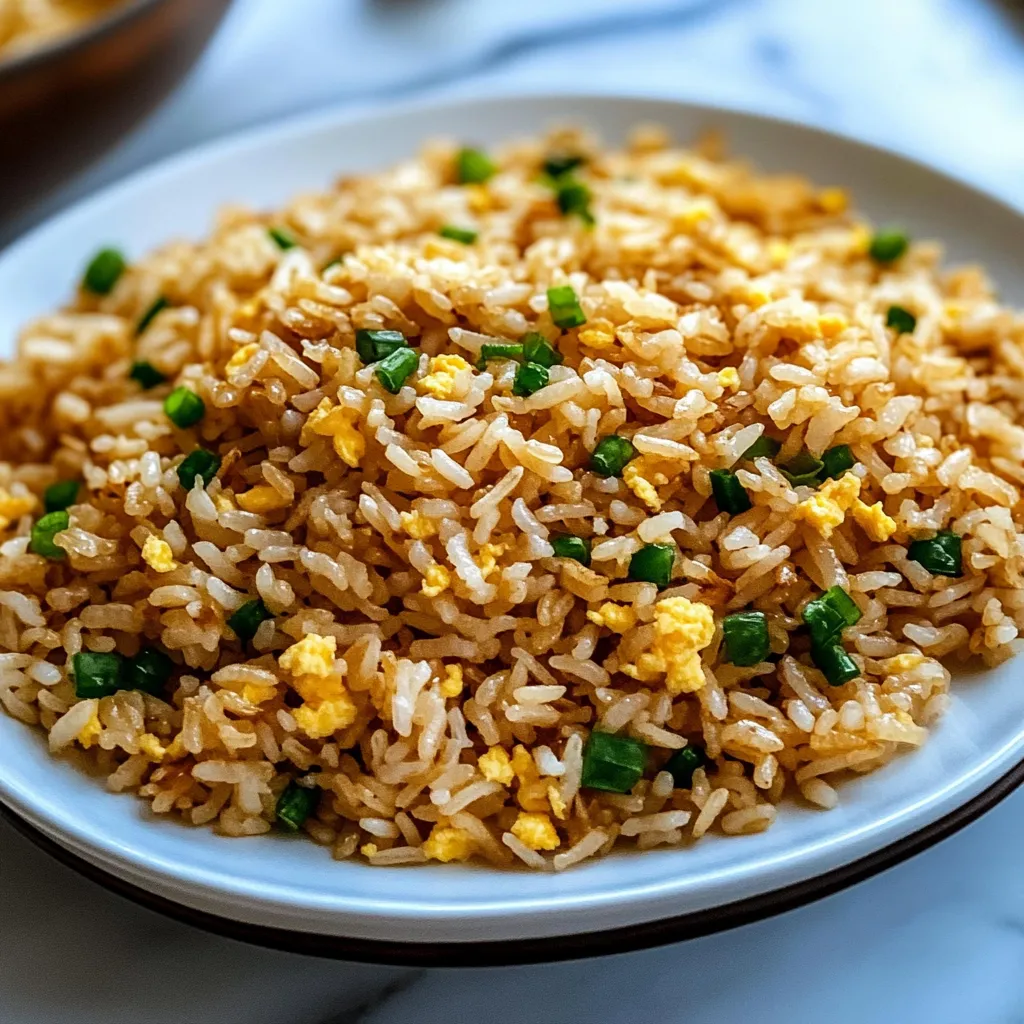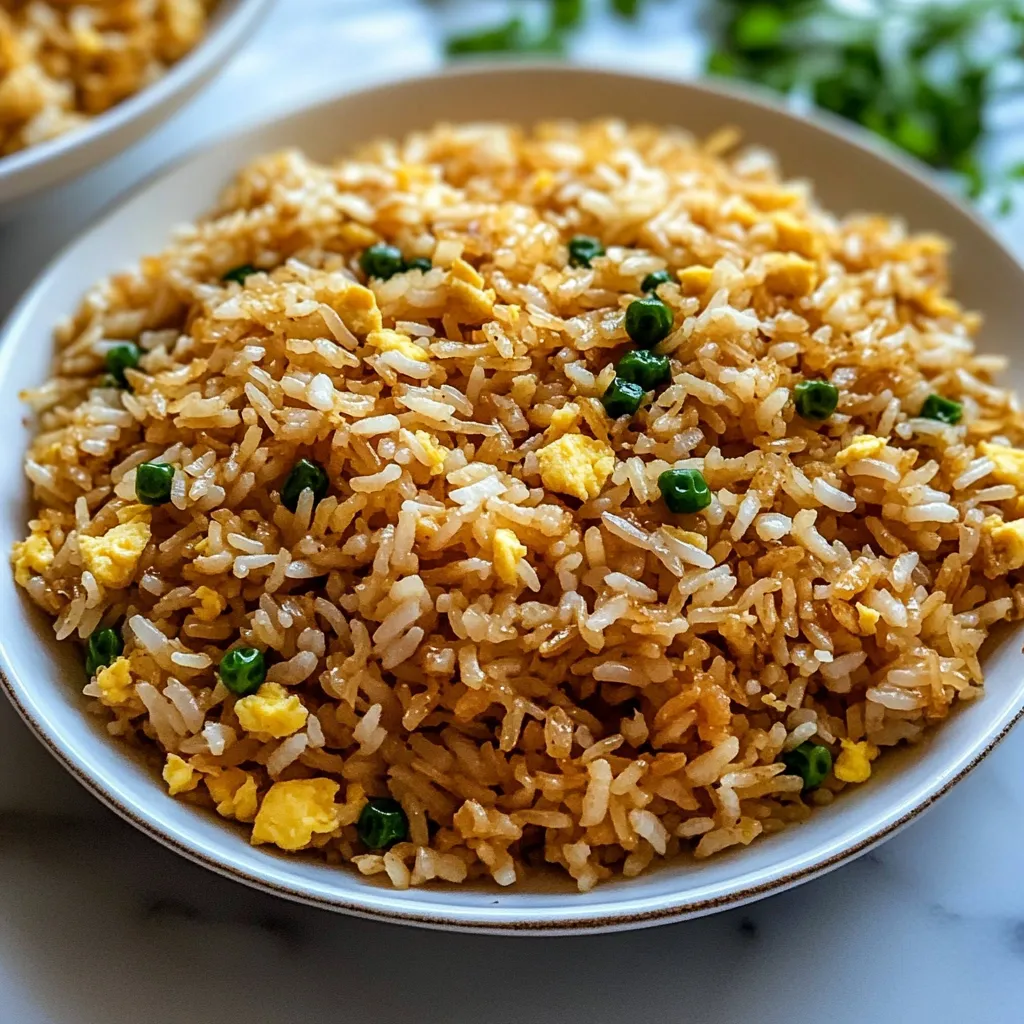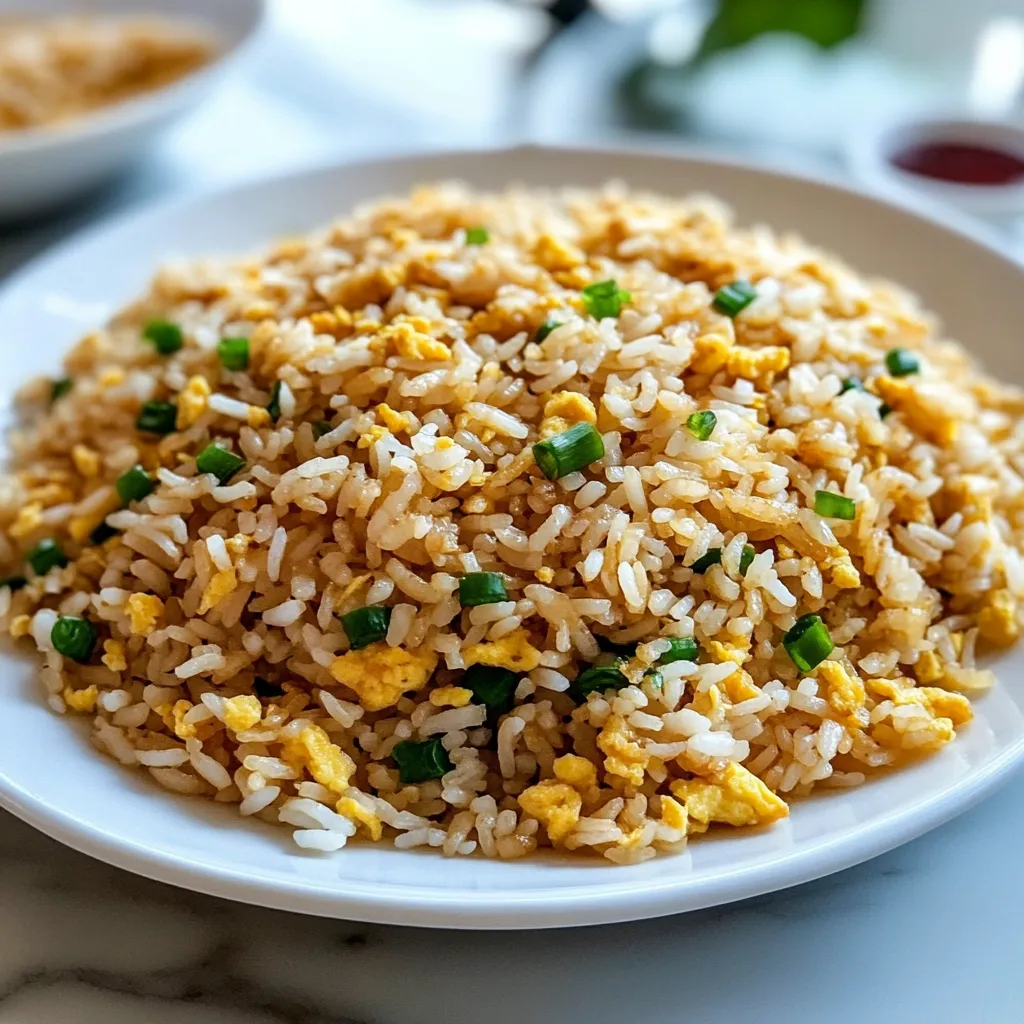 Pin it
Pin it
This classic egg fried rice recipe transforms leftover rice into a delicious meal in just 10 minutes. The beauty of this dish lies in its simplicity and the way each ingredient complements the others to create something far greater than the sum of its parts.
I first learned to make this egg fried rice during my college years when I needed quick, affordable meals. What started as a necessity has become one of my most requested dishes when friends come over for casual dinners.
Ingredients
- Cold leftover jasmine rice: The key ingredient that creates the perfect texture. Fresh rice tends to be too sticky, while day-old rice from the refrigerator gives you those perfect separated grains.
- Large eggs: Provides protein and creates a silky texture throughout the dish. Farm-fresh eggs with bright orange yolks add beautiful color.
- Vegetable oil: A neutral oil with a high smoke point is essential for proper wok cooking. Canola or peanut oil works well too.
- Regular soy sauce: Adds the perfect salty umami flavor. Avoid dark soy sauce which is too intense for this dish.
- Sesame oil: Just a small amount adds tremendous nutty aroma and authentic flavor.
- Green onions: Adds fresh flavor and color. The white parts provide crunch while the green parts offer a mild onion flavor.
Step-by-Step Instructions
- Prepare Your Workspace:
- Set all ingredients within arm's reach before turning on the heat. This dish comes together quickly, and having everything ready prevents burning or overcooking. Make sure your rice is broken up and not in one solid block from the refrigerator.
- Heat Your Wok:
- Place your wok or large skillet over medium-high heat and add 1 tablespoon of vegetable oil. Allow the pan to get very hot until you see the faintest wisps of smoke. This high heat is crucial for authentic wok cooking and prevents the rice from sticking.
- Cook The Eggs:
- Pour your beaten eggs into the hot oil. They will begin to set almost immediately. Use your spatula to gently move them around, creating soft folds rather than scrambling them too finely. You want visible pieces of egg in your final dish.
- Add The Rice:
- When the eggs are about 80% cooked but still slightly wet, add your cold rice to the pan. Break apart any clumps with your spatula and toss everything together. Keep everything moving to prevent sticking and to distribute the heat evenly.
- Incorporate Green Onions:
- Push everything to one side of the pan to create an empty space. Add the remaining tablespoon of oil to this space and toss in your chopped green onions. Let them sizzle for about 10 seconds to release their aroma before mixing everything together.
- Season The Dish:
- Drizzle the soy sauce and sesame oil around the edges of the wok rather than directly on the ingredients. This allows the sauce to heat up as it runs down the hot sides of the pan, intensifying the flavor before it hits the rice.
- Final Toss:
- Using a lifting and folding motion, thoroughly combine all ingredients until the rice is uniformly colored from the soy sauce. This should take about 1-2 minutes. The rice should be hot throughout and lightly browned in spots.
 Pin it
Pin it
The secret to truly exceptional egg fried rice lies in understanding wok hei, or the breath of the wok. This is that slightly smoky, charred flavor that comes from cooking at extremely high heat. My grandmother taught me that the sound of ingredients hitting a properly heated wok should be almost musical – a satisfying sizzle that signals you're on the right track.
The Rice Makes All The Difference
The type and condition of your rice dramatically impacts the final dish. Jasmine rice works beautifully because of its naturally fragrant quality and ability to remain distinct when fried. The most important thing is using rice that's been cooled completely. Fresh rice contains too much moisture and will turn mushy when stir-fried. If you're in a hurry, spread freshly cooked rice on a baking sheet and place it in the freezer for 15-20 minutes to rapidly cool it down.
Customization Options
Once you master this basic recipe, the variations are endless. Add diced carrots, peas, or corn for color and nutrition. Include diced ham, shrimp, or chicken for a more substantial meal. For a spicy kick, incorporate a teaspoon of chili oil or sriracha. Vegetarians can skip the eggs and add extra vegetables or tofu. I particularly love adding kimchi for a Korean-inspired version that adds wonderful tanginess and complexity.
Serving Suggestions
While egg fried rice is certainly delicious on its own, it pairs wonderfully with other Asian dishes. Serve it alongside kung pao chicken, beef and broccoli, or ma po tofu for a complete meal. For a simpler approach, add a side of steamed vegetables or a fresh cucumber salad to balance the richness of the fried rice. A small bowl of hot and sour soup makes a wonderful starter before the main course.
 Pin it
Pin it
Enjoy this egg fried rice as the ultimate quick-and-easy weeknight meal packed with flavor!
Frequently Asked Questions
- → Why is cold, day-old rice recommended for fried rice?
Cold, day-old rice is drier and less sticky than freshly cooked rice. This prevents clumping during stir-frying and helps each grain remain separate, creating the perfect texture for fried rice.
- → Can I add vegetables or protein to this fried rice?
Absolutely! This is a versatile base recipe. Popular additions include peas, carrots, corn, diced bell peppers, bean sprouts, cooked chicken, shrimp, or cubed ham. Add vegetables after the eggs and protein when nearly finished.
- → What's the difference between regular and dark soy sauce?
Regular soy sauce provides flavor without significantly coloring the rice. Dark soy sauce is thicker, less salty, and primarily used for adding a deep color to dishes. This recipe calls for regular soy sauce for balanced flavor without darkening the rice too much.
- → How can I make fried rice if I don't have leftover rice?
If you need to make fresh rice, spread it on a baking sheet and place in the refrigerator uncovered for 1-2 hours to cool and dry out. Alternatively, cook rice with slightly less water than usual, then cool it completely before stir-frying.
- → Is a wok necessary for making good egg fried rice?
While a wok is traditional and provides excellent heat distribution, any large non-stick skillet or frying pan works well. The key is using high heat and keeping the ingredients moving to prevent sticking and achieve that signature wok hei flavor.
- → What oils work best for fried rice?
Neutral oils with high smoke points like vegetable, canola, peanut, or grapeseed oil are ideal for the high-heat cooking required. The sesame oil added at the end is for flavor rather than cooking, as it has a lower smoke point.
